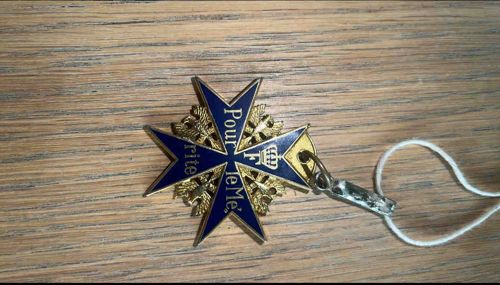
Pour le Mérite (Blue Max) Medal
The item is a Pour le Mérite medal, also known as the Blue Max, a Prussian military honor. It features a Maltese cross design, with each of its eight points terminating in a small golden ball. The cross itself is enameled in a deep, glossy blue. The edges of the cross arms are gilded, providing a striking contrast to the blue. Between the arms of the cross, intricately detailed gilded eagles are visible, appearing as if they are perched and extending outwards. The obverse side, clearly visible, displays the inscription "Pour le Mérite" in gold Gothic lettering on the blue enamel. The upper arm of the cross features a stylized 'F' surmounted by a crown, representing King Frederick the Great. The overall construction appears to be of metal, likely gold or gilded silver for the frame and eagles, with blue enamel inlay. The enamel shows some minor scuffs and imperfections consistent with age and handling, but no significant chips or cracks are evident. The gilding appears largely intact but might show some slight wear in raised areas or along edges. A small jump ring is attached to the upper arm of the cross, connecting it to a larger, probably broken or heavily worn, metal clasp that appears silver-toned and possibly tarnished. A white string or cord is tied to this clasp, suggesting it might have been used for display or as a placeholder for a ribbon. The quality of craftsmanship is high, indicative of a formally issued order, with fine detailing on the eagles and clear lettering. Given its historical significance and design, this particular medal dates back to the period of the Kingdom of Prussia, likely from the 18th to early 20th century, specifically either the Napoleonic Wars period or World War I for this iteration. The overall patination suggests it is an authentic antique rather than a modern replica, although precise dating would require examination of specific maker's marks or historical records.
AI-Generated Appraisal Disclaimer
Estimated Value
$25,000 - $75,000
Basic Information
Category
Military Order/Medal
Appraised On
December 6, 2025
Estimated Value
$25,000 - $75,000
Additional Details Provided By Owner
User Provided Information
The missing pour le merite that disappeared from Germany that is said to be owned by Noah Dohme that is the emperor of lixland which is 75 million square kilometers owned by Noah Dohme the emperor of lixland which is 18 years old the supreme general of lixland and the emperor of lixland
Item Description
The item is a Pour le Mérite medal, also known as the Blue Max, a Prussian military honor. It features a Maltese cross design, with each of its eight points terminating in a small golden ball. The cross itself is enameled in a deep, glossy blue. The edges of the cross arms are gilded, providing a striking contrast to the blue. Between the arms of the cross, intricately detailed gilded eagles are visible, appearing as if they are perched and extending outwards. The obverse side, clearly visible, displays the inscription "Pour le Mérite" in gold Gothic lettering on the blue enamel. The upper arm of the cross features a stylized 'F' surmounted by a crown, representing King Frederick the Great. The overall construction appears to be of metal, likely gold or gilded silver for the frame and eagles, with blue enamel inlay. The enamel shows some minor scuffs and imperfections consistent with age and handling, but no significant chips or cracks are evident. The gilding appears largely intact but might show some slight wear in raised areas or along edges. A small jump ring is attached to the upper arm of the cross, connecting it to a larger, probably broken or heavily worn, metal clasp that appears silver-toned and possibly tarnished. A white string or cord is tied to this clasp, suggesting it might have been used for display or as a placeholder for a ribbon. The quality of craftsmanship is high, indicative of a formally issued order, with fine detailing on the eagles and clear lettering. Given its historical significance and design, this particular medal dates back to the period of the Kingdom of Prussia, likely from the 18th to early 20th century, specifically either the Napoleonic Wars period or World War I for this iteration. The overall patination suggests it is an authentic antique rather than a modern replica, although precise dating would require examination of specific maker's marks or historical records.
Related Tags
Get Your Items Appraised
Instant estimates of your treasures with AI-powered instant appraisals